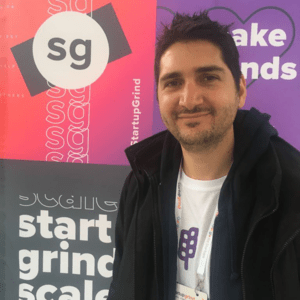I’m a computer engineer transformed into a ⚙️ passionate No Coder ⚙️. Reach out if you want to get introduced or learn more about the No Code world!
It’s not so complicated: From sales-led to product-led growth
Here are some Product-Led Growth misconceptions:
- Product-Led Growth is not as new as people might think, the label is new
- It’s also harder to implement than the majority of people think
Here are some PLG traps:
- neglecting how much time is required to transition to Product-Led Growth
- sales leading the transition to Product-Led Growth
In this episode, you’ll hear about:
- the mistake of companies having sales lead the transition to Product-Led Growth
- Product-Led Growth being confused with growth marketing
- examples of Sales-Led Growth vs Product-Led Growth
- decreasing time to value and NOT handholding users along their journey
- the Zoom and 1Password examples
Tools mentioned:
- Elena Verna and Product-Led as resources to find more about PLG and relevant frameworks
- Onboarding.study to learn about onboarding journeys from the best SaaS
And all these in less than 15 min.
Transcript
Mario Araujo: Hey, I’m Mario, Head of Growth at Softr.io. Been doing product growth for the past many years, actually. And yeah, that’s me.
Spyros Tsoukalas: Mario, welcome to the Growth Mentor podcast, given your career and your backgrounds, I’m excited to discuss about Product-Led Growth today. So would you tell us something that we don’t know about PLG?
Mario Araujo: Yeah, that’s a that’s a that’s a good one. PLG, I would say a couple of things. Maybe one is PLG is not as new as one might think. The label is new. And it’s also harder to implement than the majority of people think. Yeah, so those would be the two things that are maybe intuitive to many. But even though intuitive people forget, at times, especially the second one.
Spyros Tsoukalas: What do you see going wrong when startups or software companies use PLG in their strategy?
Mario Araujo: So, um, so good question. And I see a couple, a couple of mistakes when you are a couple of traps that people fall into. So for bigger, bigger companies that want to transition from a model, from a traditional sales lead model to product-led growth, the typical trap they fall into, is thinking that they will make the call and then next quarter, they will make the numbers as if it was magic. They often neglect the fact that it may take many quarters to get to get the motion running. It’s not going to go as fast as people have in their heads. So that’s that’s a, that’s a, that’s a typical trap, which is most often in my experience, associate experience associated with the fact that they get they put sales, leading the transition, which is a mistake, because sales are sales teams are incentivized to make the numbers quarter over quarter, not to make a strategic transformation of the company for the next two years. And so the two incentives collide, on one hand, you want to do a transformation, that’s a marathon, not a sprint. On the other hand, you want to make the next quarter. And so that’s one of the things that I’m that I’m seeing on bigger companies. On smaller companies, smaller startups, say Series A, Series B up to series A Series B, what I often see is a confusion, I guess, of what product-led growth is. It’s often confused with growth marketing, and the two disciplines need to exist. But one is, you know, the traditional marketing or invest in paid marketing, SEO and whatnot. In the other one, in product-led growth, you’re you’re trying to leverage your growth, your product as a growth as a growth engine. And you need to do a lot of research a lot of experimentation, and have your metrics straight. So you can actually make the difference. And often, often I see startups, making the mistake of mixing up the due, and even messing up the team composition there, to what ends ends up being an unsuccessful implementation. But it’s all it’s it’s a self fulfilling prophecy. In most cases, you don’t have the right team nor the right goals, not the right expectations, and then things fail.
Spyros Tsoukalas: I have experienced some of those cases that you mentioned in the past. But I’m very curious, could you elaborate a little more regarding the differences between sales-led growth and product-led growth, like especially for startups, or like not extreme, extremely big companies. Like how do these two methodologies or approaches differentiate and like pros and cons?
Mario Araujo: So I’ll give you two examples that you’ll easily be able to look up on the web and follow. If you go today, for example, to workday.com, the HR, the HR solution and you want to get started with that solution. There’s a big button there that allows you to get started. But the call to action after that is essentially is essentially a talk to sales action. So you are unable to use the product, you are unable to experiment before using it. Most likely, because there are reasons for this most likely because work they requires quite a bit of setup, or they’re they’re targeting bigger companies and bigger companies require a different level of touch during the sale. So that’s a sales-led company. Sales lead company, is the buyer journey is built with the assumption that there’s always going to be really good people hand holding the buyer throughout the journey. It’s normally associated with complex products that require even multiple people to evaluate. And also bigger deal sizes. Right off the bat. you contrast that, for example, with softr.io, which is the company that I work for, we don’t even have a sales team. We don’t have a customer success team. We, we hardly have a marketing team eight months ago. So this is, what happens is that a buyer comes to Softr, they expect they use the product for a week or so. And then they upgrade or they stay in the free or they go away. The typical time to sale is fast, and there are no humans involved. There are also up until very recently, there was even no marketing involved attracting users to Softr, it was purely word of mouth and virality within the product. So this is the contrast. I bet that workday has bigger deal sizes, initial deal sizes, then we do and that’s okay. But we are set up and many people ask us, Why don’t you hire sales team? It’s sort of the way the company is built. So anyway, so these would be sort of two examples that will help you contrast the the two.
Spyros Tsoukalas: They were very clear. And I think I got exactly what we were trying to say having experienced platforms like Softr or experiences like the workday example. So if a startup wants to transition, or a company from the sales-led growth approach to the product-led growth, how would you do it? How would you execute this transition?
Mario Araujo: Yeah, that’s a good question. So a startup, maybe a startup won’t have a problem. They’re smaller, they’re nimble, they can pivot, you know, it’s a series a series B, they can pivot. What do you what you probably can’t do as a startup is be both, because there will not be enough resources. And I see some startup struggling, struggling with this, they want to be the company for the prosumer. But they also want to be the company that sells to the big companies. And and it’s just really difficult, I think to do really have in fact, in both given the constrain how constrained they are, as far as resources is concerned, if you’re a big company, say 1000 people plus, and you have like, maybe a 20, 50 people sales team, and maybe a 20, 30 people marketing team, who’s been doing heavy B2B sales led driving the B2B sales side of the business, transitioning will require a couple of things. Actually, more than a couple, first thing is understand really what your you want to get out of it. Why is it that you want to transition? What is your expectation? And most often, in my conversations, they are trying to solve a demand generation problem. They’re trying to get more people into their product, the challenge is that their product became their product was built to have someone hand holding users throughout the beginning. So, the time to value, the time for people to get value of that product is really long, sometimes 3, 6, 9 months. So, to really be effective transitioning, you really have to tackle the time to value of your product. So that is almost always the first thing I recommend companies to do is to address, is to shorten the time it takes for people to get the value. In parallel, by doing this, the second order effect will be that you won’t need so much handle thing. So, that’s that’s one approach. You can go for the let’s let’s simplify our product and even if you’re unsuccessful with PLG, your product will be a better product after this journey. Yeah, so that’s, that’s one of the topics that I recommend companies to do. The other is maybe you come up with a simpler product or a dumbed down version of your product that solves a simpler problem. And you launch that with a PLG motion in the hopes that one, the smaller product will bring people to the bigger product. But yeah, there there will be that that’s that’s a challenge that that we’re seeing in some companies also in the market. So for example, Celonis, which bought make.com, the Zapier competitor, they’re like, why would such a big company buy such as, you know, different products that they target completely different audiences, right? And why, why? And my guess is that they’re trying to fast track a PLG movement to help the Celonis group as a whole grow. But then they have a challenge that the target market of makers completely different than the target market of Celonis. But unfortunately, fortunately, make.com is a great product as it stands. So, I don’t know if they will be successful merging the two or not, but but at least they’re separately being successful in both in both. So anyway, that’s if you have money, you can also buy your your, you can also buy your way into PLG.
Spyros Tsoukalas: At what stage then do you think that startups or companies that are growing since start paying attention to product led approaches?
Mario Araujo: Well, I’ll give you two examples, which are very interesting to me, I was just researching about these yesterday, yesterday, actually. So take 1Password, for example, everyone, or almost everyone knows 1Password, 1Password is the, you know, allows you to store your passwords. So you don’t have to memorise them in a secure way. And if you look at their messaging two, three years ago, it was really tailored at people prosumers or people that use technology, and they don’t mind buying technology. And and that was a PLG approach, they were trying to get users into the product. Go to their site today and they’re all about selling to the enterprise now. So they started very soon, early, to get adoption to get traction. So they use what we normally referred to as a user hungry, not angry, use a hungry strategy to try and get as many users as they want it to capture the market, to cap to make a brand for themselves. And once they did, they started selling to the enterprise. The other example similar, very similar to this, that was accelerated by COVID was Zoom. Same pattern they were they were being adopted left and right by people, school schools and whatnot. And then they started the they added on the the enterprise led motion. So, that’s normally what happens for some companies. Companies that do the opposite. It’s much harder to go from a place where you’re targeting fortune 5000 or 10,000 to PLG because because of the reasons I mentioned earlier. So, my if you can I would start bottom up first and then add on later the enterprise that sales led motion, but later not not not starting with. But again, it all, there’s so many nuances to the market companies are that, that this is hardly a rule that applies for all.
Spyros Tsoukalas: Mario, thank you very much for sharing all these practical examples. The last question for the day is, do you recommend any tools or resources to our listeners?
Mario Araujo: Yeah, so I’ll give you a few. I’ll definitely recommend you go to elenaverna.com. She’s the she’s been my mentor for a long time, she produces a bunch of frameworks. I would recommend going to ProductLed.com as well. I’m a mentor there as well. And there’s all sorts of free material that you can that you can explore. And yeah, just later, my friend Adam shared a website called onboarding.study where you can learn a bunch of what companies have been doing to optimise their onboarding journeys, which is very much related with with product life.
Spyros Tsoukalas: Mario, thank you very much for sharing all your insights with us today.
Mario Araujo: It’s alright, thank you.
Spyros Tsoukalas: I learned a ton and yeah, I hope the listeners will enjoy it as much as we did.
Mario Araujo: Yeah, was my pleasure. Thank you.
In this episode


Currently working on Softr.io, a Series A startup in the no-code space. Mostly interested in product-led growth, organic acquisition, retention and monetisation.
Join the community
Enjoy the peace of mind that advice is always only one Zoom call away.


